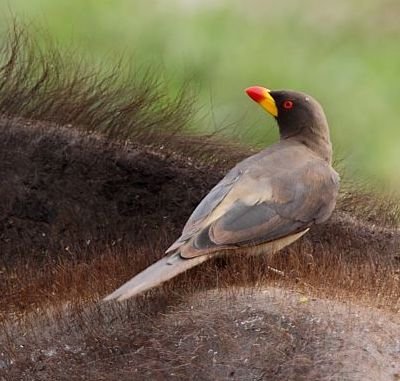Buphagidae – Oxpeckers

The oxpeckers are two species of bird which make up the family Buphagidae. Some ornithologists regard them as a subfamily Buphaginae within the starling family, Sturnidae, but they appear to be quite distinct. Oxpeckers are endemic to the savanna of Sub-Saharan Africa. Both the English and scientific names arise from their habit of perching on large mammals (both wild and domesticated) such as cattle, zebras, impalas, hippopotamuses, or rhinoceroses, and eating ticks, small insects, botfly larvae, and other parasites.
According to the more recent studies of Muscicapoidea phylogeny, the oxpeckers are an ancient line related to Mimidae (mockingbirds and thrashers) and starlings but not particularly close to either. Considering the known biogeography of these groups, the most plausible explanation seems that the oxpecker lineage originated in Eastern or Southeastern Asia like the other two. This would make the two species of Buphagus something like living fossils, and demonstrates that such remnants of past evolution can possess striking and unique autapomorphic adaptations.
The oxpeckers are endemic to sub-Saharan Africa, where they occur in most open habitats. They are absent from the driest deserts and the rainforests. Their distribution is restricted by the presence of their preferred prey, specific species of ticks, and the animal hosts of those ticks. The two species of oxpecker are sympatric over much of East Africa and may even occur on the same host animal. The nature of the interactions between the two species is unknown.
Oxpeckers graze exclusively on the bodies of large mammals. Certain species are seemingly preferred, whereas others, like the Lichtenstein’s hartebeest or Topi are generally avoided. Smaller antelope such as lechwe, duikers and reedbuck are also avoided; the smallest regularly used species is the Impala, probably because of the heavy tick load and social nature of that species. In many parts of their range they now feed on cattle, but avoid camels. They feed on ectoparasites, particularly ticks, as well as insects infesting wounds and the flesh and blood of some wounds as well. They are sometimes classified as parasites, because they open wounds on the animals’ backs.
Oxpecker/mammal interactions are the subject of some debate and ongoing research. They were originally thought to be an example of mutualism, but recent evidence suggests that oxpeckers may be parasites instead. Oxpeckers do eat ticks, but often the ticks have already fed on the ungulate host and no statistically significant link has been shown between oxpecker presence and reduced ectoparasite load. Oxpeckers have been observed to open new wounds and enhance existing ones in order to drink the blood of their perches. They also feed on the earwax and dandruff of mammals; less is known about the possible benefits of this to the mammal, but it is suspected that this is also a parasitic behaviour. Some oxpecker hosts are intolerant of their presence. Elephants and some antelope will actively dislodge the oxpeckers when they land. Other species tolerate oxpeckers while they search for ticks on the face, which one author says “appears … to be an uncomfortable and invasive process.
The breeding season of the oxpeckers, in at least one location, is linked to the rainy season, which affects the activity of their mammalian hosts and the tick loads of those hosts. Both courtship and copulation occur on their hosts as well. They nest in holes, usually in trees but sometimes in other types of cavity, including holes in walls. The nests are lined with grasses and often with hair plucked from their hosts and even livestock such as sheep which are not usually used. The typical clutch is between two and three eggs, but the Red-billed Oxpecker may lay up to five eggs.
The Buphagidae family has recently been delineated following DNA sequencing and has just two Oxpecker species listed below.
Red-billed Oxpecker Buphagus erythrorhynchus
Yellow-billed Oxpecker Buphagus africanus
-
Red-Billed Oxpecker Buphagus erythrorhynchus
IUCN Species StatusIUCN species profile... -
Red-Billed Oxpecker Buphagus erythrorhynchus
Species AccountThe red-billed oxpecker (Buphagus erythrorhynchus) is a passerine bird in the starling and myna family, Sturnidae; some ornithologists regard the oxpeckers to be in a family by themselves, the Buphagidae. It is native to the savannah of sub-Saharan Africa, from the Central African Republic east to South Sudan and south to northern and eastern South Africa. Its range overlaps that of the less widespread yellow-billed oxpecker. -
Yellow-billed Oxpecker Buphagus africanus
IUCN Species Status -
Yellow-billed Oxpecker Buphagus africanus
Species AccountSound archive and distribution map. -
Yellow-billed Oxpecker Buphagus africanus
Species AccountThe yellow-billed oxpecker (Buphagus africanus) is a passerine bird in the starling and myna family, Sturnidae; some ornithologists regard the oxpeckers to be a separate family, the Buphagidae (Zuccon, 2006). It is native to the savannah of sub-Saharan Africa from Senegal east to Sudan. It is least common in the extreme east of its range where it overlaps with the red-billed oxpecker, despite always dominating that species when feeding.
-
Number of bird species: 2
